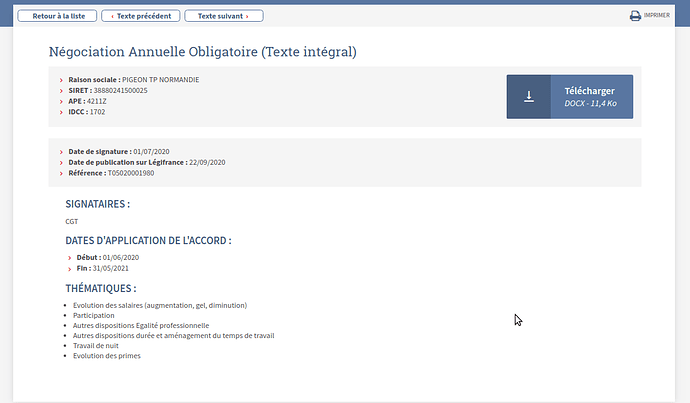Pour être plus précis, l’outil ne scrape qu’un seul résultat par page… Voici le sitemap :
{"_id":"legifrance_6","startUrl":["https://www.legifrance.gouv.fr/liste/acco?theme=yLLj7Q%3D%3D&theme=RdBp6A%3D%3D&theme=Y7GKEQ%3D%3D&theme=VyAacA%3D%3D&sortValue=DATE_PUBLI_DESC&pageSize=10&page=[1-100]&tab_selection=all#acco"],"selectors":[{"id":"fiches entreprises","type":"SelectorElementClick","parentSelectors":["_root"],"selector":"h2","multiple":true,"delay":2000,"clickElementSelector":".title-result-item a","clickType":"clickMore","discardInitialElements":"do-not-discard","clickElementUniquenessType":"uniqueText"},{"id":"raison","type":"SelectorText","parentSelectors":["_root"],"selector":"div.frame-block:nth-of-type(1) li:nth-of-type(1)","multiple":true,"regex":"","delay":0},{"id":"siret","type":"SelectorText","parentSelectors":["_root"],"selector":"div.frame-block:nth-of-type(1) li:nth-of-type(2)","multiple":false,"regex":"","delay":0},{"id":"ape","type":"SelectorText","parentSelectors":["_root"],"selector":"div.frame-block:nth-of-type(1) li:nth-of-type(3)","multiple":false,"regex":"","delay":0},{"id":"idcc","type":"SelectorText","parentSelectors":["_root"],"selector":".picto-list li:nth-of-type(4)","multiple":false,"regex":"","delay":0},{"id":"thématiques","type":"SelectorText","parentSelectors":["_root"],"selector":"div.content-page:nth-of-type(6)","multiple":false,"regex":"","delay":0}]}
Si vous avez des idées je suis preneur !

